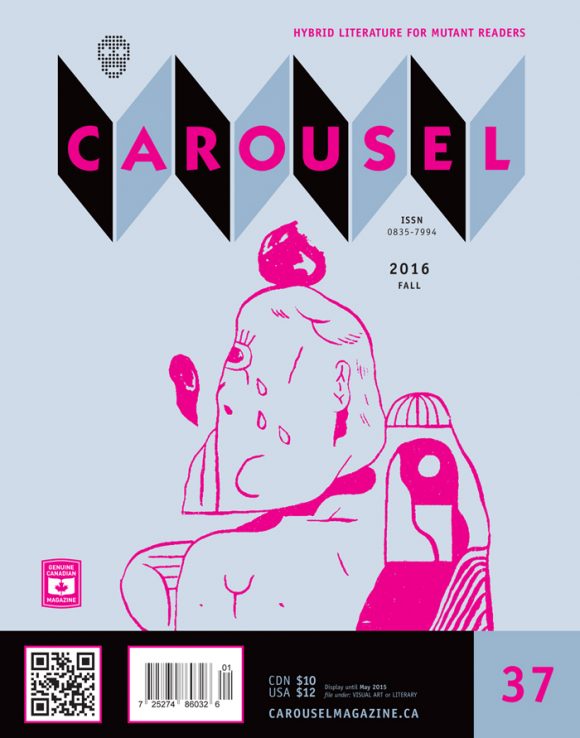From the Archive: “But the mouse can make a nest in you”: Richard Kraft + Danielle Dutton Interviewed (CAROUSEL 37)
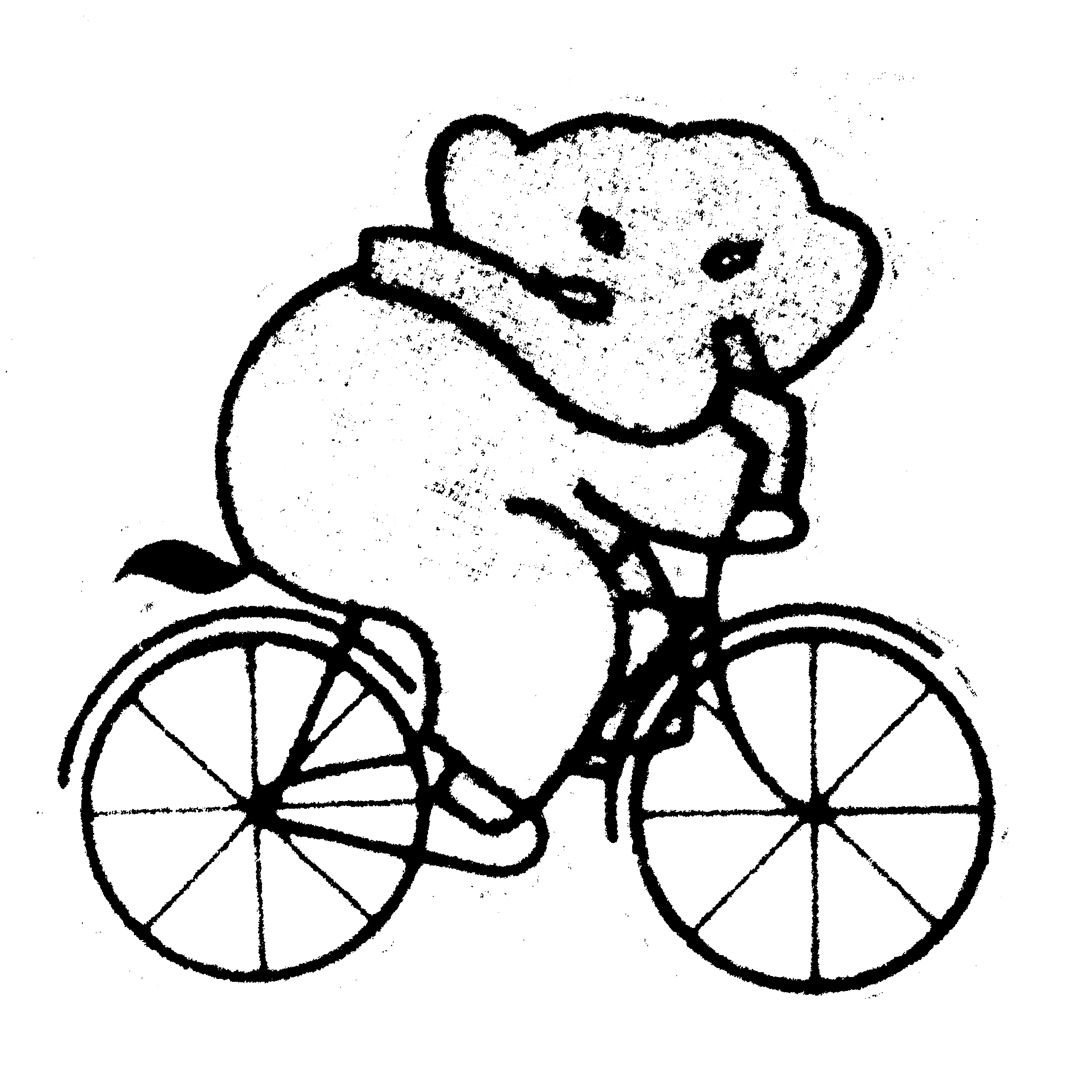
Los Angeles artist Richard Kraft’s Here Comes Kitty: A Comic Opera is a wildly irreverent collage narrative that challenges at every turn.
To create his dreamlike paper opera, Kraft worked directly over an issue of Kapitan Kloss — a Cold War comic about a Polish spy infiltrating the Nazis — superimposing a cast of strange new voices and characters on top of it. “A riot of images and words”, the resulting project is arbitrary, inventive and structurally chaotic.
Nested at regular intervals within Kitty’s comic book architecture is an unconventional collaboration with/by writer Danielle Dutton. Her sixteen disruptive Interpolations — surreal texts that parallel Kraft’s core strategies of appropriation and juxtaposition — punctuate the book, singing in the same arresting register as Kraft’s delightful comic book collages.

Interviews conducted February, 2016
RICHARD KRAFT — website
It’s wonderful to see a complex hydrid-lit project like this in print. How did Here Comes Kitty end up with Siglio?
Thanks Mark. I’m so glad you like it! Actually, Siglio Press was founded by my wife Lisa Pearson primarily as a result of a very particular conversation between her, our dear friend, the artist Robert Seydel and myself. We had just seen a Joe Brainard show at Tibor de Nagy in New York and afterwards, walking down the street, we were discussing the fact that Brainard is much less celebrated than he should be. In part we put this down to the hybrid nature of his work and the fact that (as a painter, a collage artist and a writer) he was devoted to, and a master of the small gesture. Siglio’s first book was The Nancy Book by Joe Brainard, and its mission is to make a space and advocate for works like this that live between art and literature.
Were there concerns over the extensive use of the Kapitan Kloss comic book property, and if so, how did those resolve?
Honestly, I wasn’t concerned at all given that the original comic is so heavily reworked. Not long before I finished the project a friend visited my studio. When I showed him the issue of Kapitan Kloss I used, he remarked that, in contrast to the collages, it appeared extremely violent. It was almost as if he couldn’t locate the original comic in the collages. Also, it was important to me that we credited Andrzej Zbych and Mieczyław Wisniewski as the authors of Kapitan Kloss because their comic was my initial inspiration.
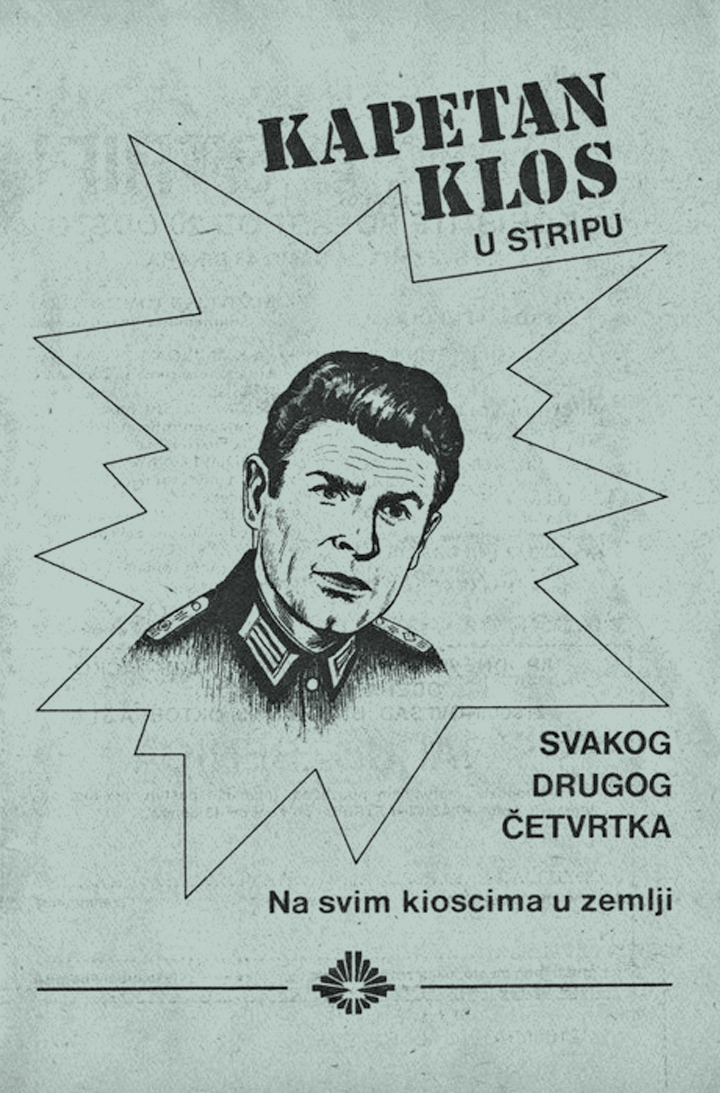
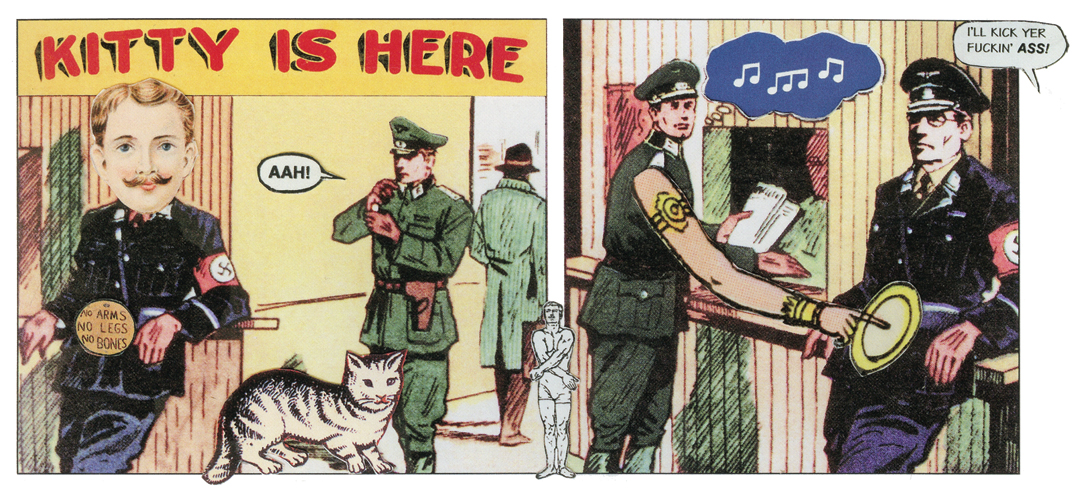
Your initial decision to use an issue of Kapitan Kloss as a guiding constraint is a really interesting move. By choosing to build your opera over the architecture of a previous work, I can’t help but see this as a remix project. What are your thoughts on remixing?
Well, as you might imagine, it’s a form I find endlessly fascinating and filled with possibilities. Some years ago I read John Cage’s assertion that all an artist needs to do is brush one thing against another. It seems to me that this is at the heart of the remix. I can think of a number of Cage pieces that have been particularly important to me in relation to this, but if I had to name one it would be Roaratorio, an Irish Circus on Finnegans Wake. It’s a complicated piece, in which a text (created using Joyce’s book as the source) is spoken/sung over multiple layers of recorded sounds. The result is a dense weave of layers and it’s a new experience each time I listen. So, for me a really well executed remix is one which offers countless possibilities; in other words, it’s successful when it can never be wholly understood, because it’s always shifting and morphing into something new.
In music, the remix has been popularized, and the culture at large has completely absorbed the exploratory possibilities of the form. In comics, however, this is still a radical gesture — we’re talking about a subculture that hasn’t done a good job of processing the motives and meaning of pop artist Roy Lichtenstein gallery adaptations of the comic book style from a half century ago. Many still see this kind of thing as an affront to their chosen art form, rather than a collapsing of boundaries.
One of the really lovely things that’s happened since Here Comes Kitty was published is that the (experimental) comic world has opened to me. While I read comics as a kid, and even as an adult, I’m not an expert and, dare I say it, don’t feel any real allegiance to comics as a form. That is, I love comics because they represent the world in extraordinary ways — they’re real and imaginary at the same time. They look like the world, yet there’s a dot screen or some other degree of separation that emphasizes their artificiality. My relationship to comics is quite similar to a Dada artist’s use of photography. (If they could’ve used a physical object from they world they would have, but when they couldn’t, a photograph worked just as well.) I’ve done a number of performance pieces in which the city or landscape becomes the canvas for a collage work, but when that’s not possible, a comic such as Kapitan Kloss is an excellent alternative.
Your comments though also make me think about an inherent conservatism, even within communities that consider themselves outside the mainstream. It’s ironic (but maybe not too surprising) that artists who consider themselves radical can hold so firmly to a very specific set of rules and parameters.
Choir boys appear at least once in almost every two-page spread throughout the book. How did the idea to develop Here Comes Kitty as “a work that’s being sung” surface?
Even before I started work on the piece, the comic felt like a libretto to me. I’m not entirely sure why that is, maybe in part because it was in Polish and therefore, for me, the language only had meaning as collections of letters, as sounds. Later, once I was working on the collages, I came to love the absurdity, or perhaps even, the impossibility of it being sung. That said, I’d love to try and perform it sometime and I’m just beginning to formulate a way to make a film out of it.
I’ve often noted that comic book writers consistently! overuse! the exclamation mark! in their scripts! Yet in the context of this collage “opera”, you capitalize on their presence in the appropriated bubbles — it’s a way to emphasize the baroque voice!! Tell us about the significance of words and how they were fit into the work?
That’s a great question Mark, and not one I entirely know how to answer. I love the fact that language is a living thing that’s constantly growing and changing. This makes it a wonderful thing to play with. In Here Comes Kitty it serves multiple roles — most obviously in the counterpoint between Danielle’s interpolations and the collages themselves. That said, I appropriated the speech bubbles from several different sources (Jimmy Swaggart’s Bible Stories, Cherry comics and Scorcher — an English comic I read as a kid — to name just a few). I imagine each of these as an invisible thread that runs through the book. Of course, what one sees (and reads) is a page that’s filled with non-sequiturs and interjections. It’s an attempt to create a space which suggests multiple conversations taking place at the same time, none of them quite making sense. (Since I was a young child I’ve been fascinated by the story of the Tower of Babel — the idea of a multitude speaking at the same time yet unable to understand what anyone else is saying. What an incredible thing it would be to witness and to listen to!) As I worked on Here Comes Kitty, I took great pleasure in putting words into character’s mouths. It’s a kind of ventriloquism I suppose, and very gratifying to have a macho looking soldier say, “I am a big girl. I sing! I sing!” Or to have an owl speak the words, “Another night – Another dream” (which is really the totemic phrase for the whole piece). Finally, language was another way to extend the piece along its continuum from the sacred to the profane, veering back and forth with multiple stops along the way.
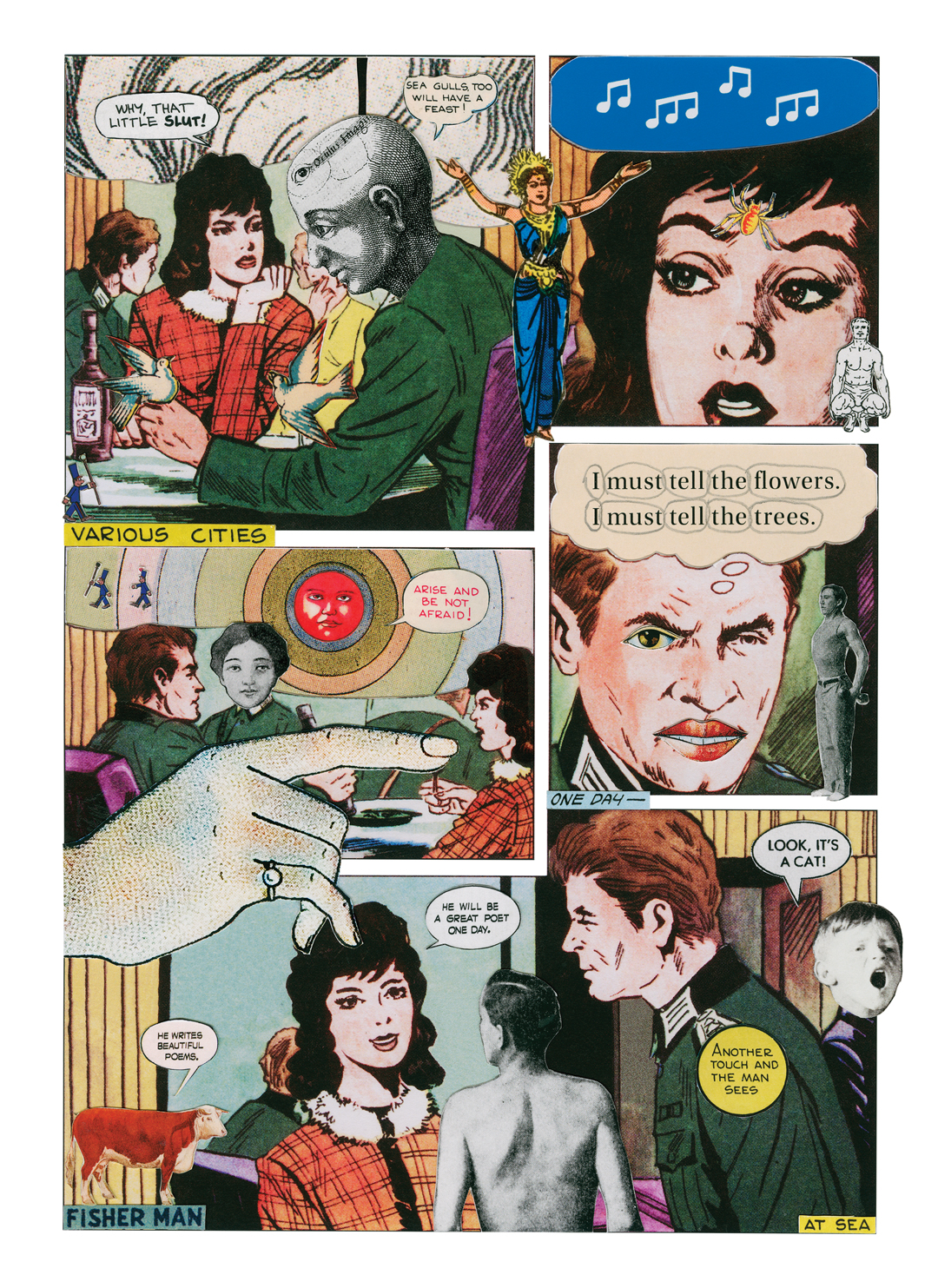
It wasn’t just a process of adding words, though. Since Kitty sits on top of the flesh of Kapitan Kloss, part of your design must certainly have been focused on erasing the visual traces of the pre-existing narrative.
I’m not sure I was focused on erasing the pre-existing narrative. If anything, it was a by-product of the process. Rather, I was more intent on using what remains of the original comic as the structure on which everything else hangs. While its “volume” may vary and it may even be quite muted in some places, hopefully it’s a voice that’s always present.
How do you balance intention and intuition?
It’s a fine line. The photographer Henri Cartier-Bresson said that thinking should be done before and after taking a photograph, never during the act itself. Obviously, a photograph is made in a fraction of a second and I might be working on a single page for hours, even days, but I work best when I’m simply playing — asking, what would happen if I put this thing next to that. This is the way I make discoveries and hopefully end up creating something that I could never have anticipated when I started. I’m most happy when I look at a finished work and find myself asking, “Wow! Where did that come from?”
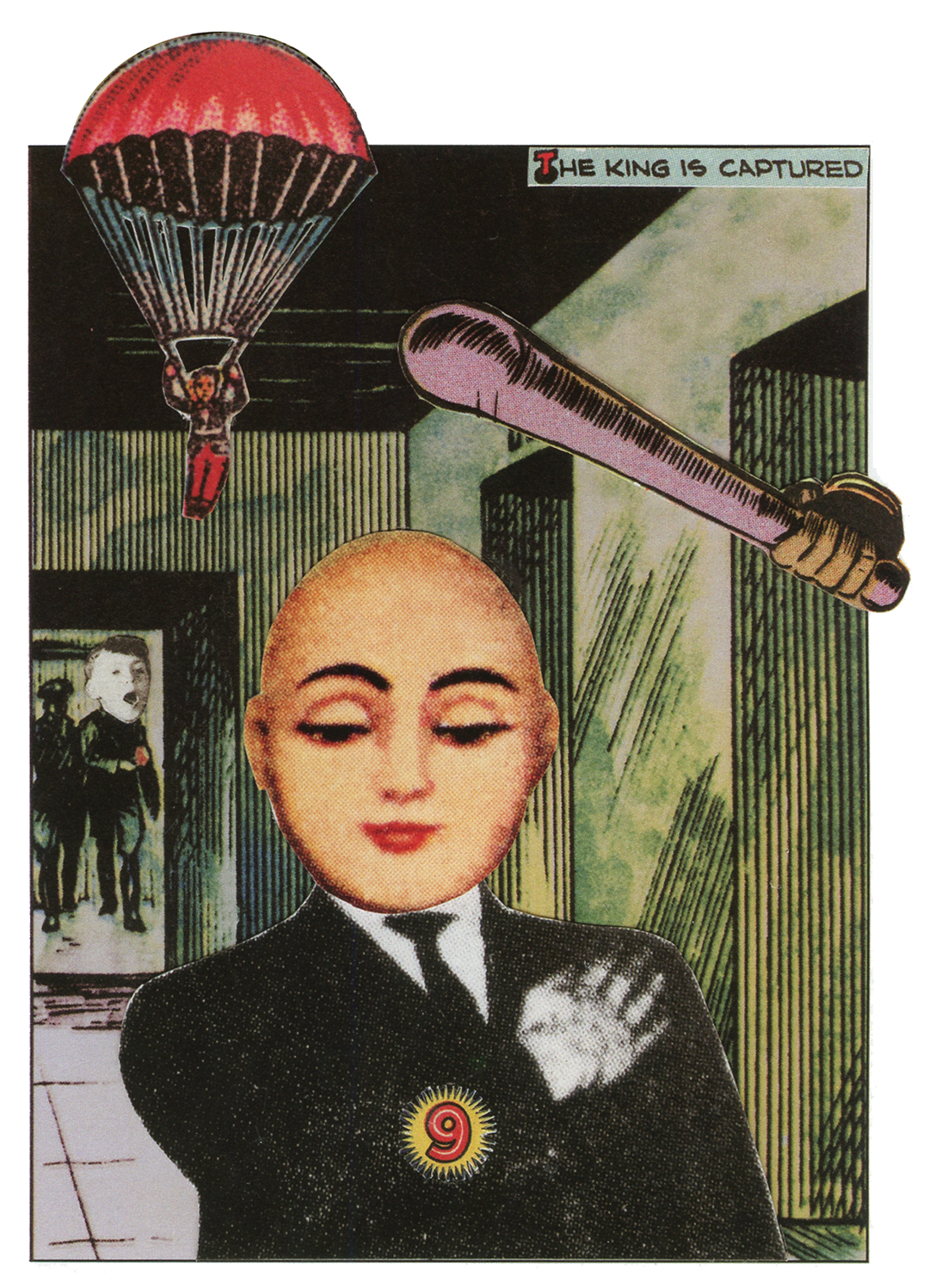
There is a ‘march’ happening in the book that offers a horizontal push through the pages of Kitty, while several parachutists move us through the panels in a vertical, gravitational pull. Can you talk about how these visual decisions direct the reader through the full sequence?
Well, it’s lovely that you call it a “march.” One of my favourite things is the marching band that I think you may be referring to. In a work that’s as dense as Here Comes Kitty, recurring motifs such as this and the parachutists you mention, seem critical to orient the reader and, as you suggest, keep the piece moving. In relationship to the push and pull you refer to, those and other motifs contribute to a very dimensional, almost fugue like structure, which serves as the foundation from which anarchic energy can spring. Within the entirety of the piece, there were multiple compositional challenges — each panel, each page and each double page spread. Then I had to consider the effect of the pages being turned, and further I was also thinking about the structure of all thirty-two pages as a single work, that would be seen on a wall, all at once. Overall though, it may be true to say that a really solid visual structure can support many different ways of looking. If I did my job well, the whole piece feels unified, yet constantly in motion, one thing always leading or pointing to another.
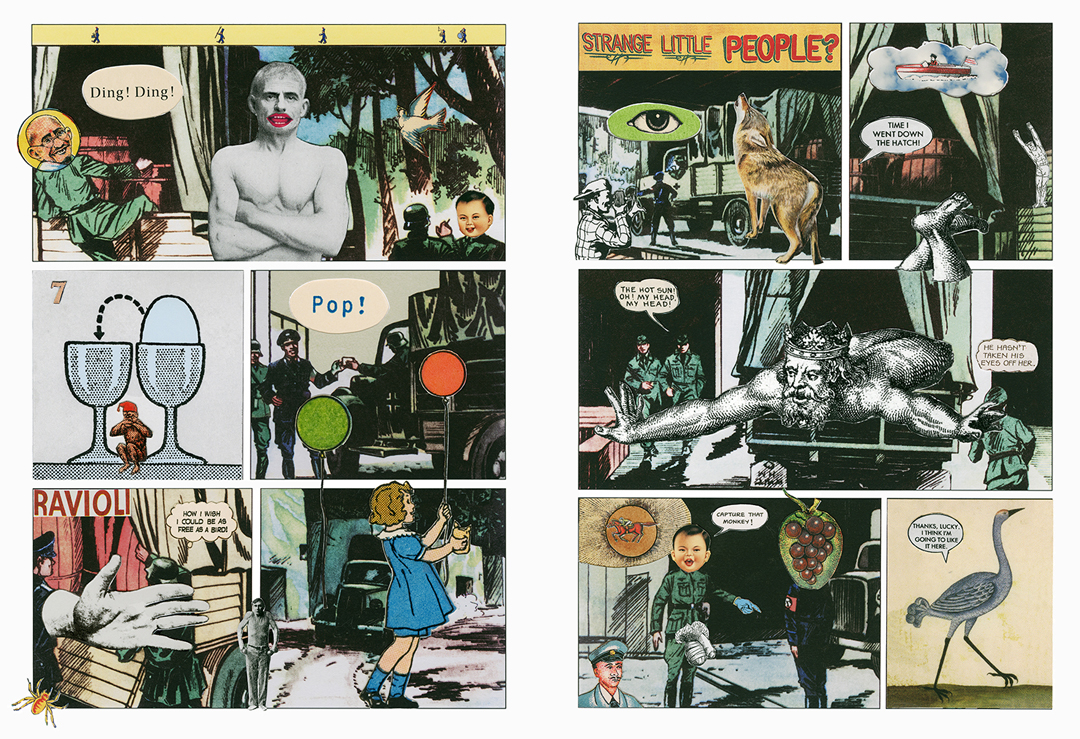
Danielle Dutton was asked to provide a series of texts — credited as ‘Interpolations’. In your acknowledgements you note that this idea was present in your mind since the project’s inception. What drew you to Danielle’s work?
I really loved Danielle’s book S P R A W L, which was also published by Siglio. It’s a book length paragraph that moves in the most extraordinary ways. Embedded in it are a series of photographs by Laura Letinsky, although you’d never know that was the case. Danielle has an incredible ability to make leaps of imagination that bring together the most unlikely things in the most natural of ways, and she was the only person I knew who could make a collection of prose pieces that would be free standing works at the same time as they would mirror and echo the collages.
Her texts purposefully breach the flow of the paneled structure of your own work as it appears in print. This is a sequencing decision; the read would have been quite different if you had chosen to group the two works into distinct sections, rather than intermingling them. Why did you do it this way?
Originally, I imagined the book as an oblique homage to the comic annuals I read as a child. I’m not sure they existed in the US or Canada, but in England, every Christmas (and even sometimes in the summer) individual comics would release a compendium that would consist of complete stories (as opposed to the serialized works in the weekly issues). Sometimes a story would be broken up into parts, with other stories and features in between. It’s similar in a way to reading a newspaper today, where an article might begin on page one and be continued several pages later. Because I get distracted by things along the way, each story becomes infused with what I’ve read in-between. So, the intention was for Danielle’s interpolations to literally break-up the flow of the collages — and vice versa. Hopefully, they each melt into each other in a particular way — as if they are independent together — which incidentally is how we worked on this. Danielle had only seen a few early pieces when she started writing and likewise, I only read short sections of what she was working on. Once we were both finished, it made perfect sense to insert four page sections of the writings into the collages.

“Eeoeooooeeeeeoooooeo” is a wonderful siren cry consisting only of vowels. It appears boldly on the first page of Kitty, and is also worked into Danielle’s opening Interpolation. What is it signaling?
Without wanting to be evasive, I’d ask you what it suggests. I particularly like Ann Lauterbach’s sense (in the conversation at the end of the book) that it’s a scream or siren. It also recalls Dada sound poems — strings of letters which look as if they might “mean” something, but actually make no rational sense at all. So, perhaps it’s a marker for the whole book, a siren cry (to use your term) to alert the reader that they are entering a world in which meaning is called into question and some of our most basic assumptions — about time and space, sense and nonsense — are turned on their head.

DANIELLE DUTTON— website
Your presence within the work is composed of sixteen single page texts interspersed in groupings of four; how did the term ‘Interpolation’ come about as a description for these written interludes?
The question we had was: what were the texts doing in/to the comics? Were they interludes? Were they interruptions? In ancient manuscripts, an interpolation is a passage not written by the original author. These new passages might be interpretive or exegetic in some way, or they could be forgeries, or they could be corrections. I guess, finally, what we all wanted was to leave the door a little open, to let the reader decide how to fit it all together (or not) as she might choose, and calling them “interpolations” seemed to allow for that.
What purpose do they serve in affecting the structure of Kraft’s comic opera?
At the very least, they provide a break in a chain of images. Even if a reader were to choose to skip them, the texts would still interrupt the movement through the comic/book on a basic level (I’m thinking of how abrupt it is to turn from Richard’s richly coloured pages to the white pages of text). But if a reader chooses to read my texts, then the way they might affect the comic opera would be more complicated. More complicated, but not for me to say. Would she read straight through the book? Would she read Richard’s opera and then come back to the Interpolations? Or maybe she’d jump around inside the whole? It just seems to me there are different ways a reader can choose to fashion the experience of this book.
“It started on a stage” seems like a declaration of sorts; as one of the earliest lines in the opening Interpolation, were you setting a stage?
Yes, definitely. Richard’s work is so bold and wild and assertive, I felt I needed, as you say, a declaration, a real sense of beginning, or else the texts could get drowned out in the energy of the rest.
Each Interpolation is mainly built out of short, sharp sentences. Is this meant to echo the way the word bubbles interject text fragments and disparate ideas throughout Richard’s paneled narrative?
I suppose so. The rhythm or voice came up for me quite naturally when I started to work. I think it might have been echoing not only the abrupt and fragmented nature of Richard’s narrative, but also the lines he places inside his images, like: “I am a bird. I sing. I sing.” I wanted to pull out that simple, declarative voice, but I also wanted to complicate it, subvert it. There’s a childlike quality to that voice, but I didn’t want my texts to read as childlike themselves.
The texts are ultimately about wandering. How did you navigate them?
What a nice question. How did I navigate them? It was really very instinctual. There was no plot, say, for me to follow or map out. I watched this voice/character on her journey through the opera. I absolutely wanted my pieces to have the feel of a narrative, the momentum of a story, but without competing against the other narratives in the book. Most of all Richard’s images themselves instigated the moves I made. I let them push me around, and then, I suppose, I pushed back a little.
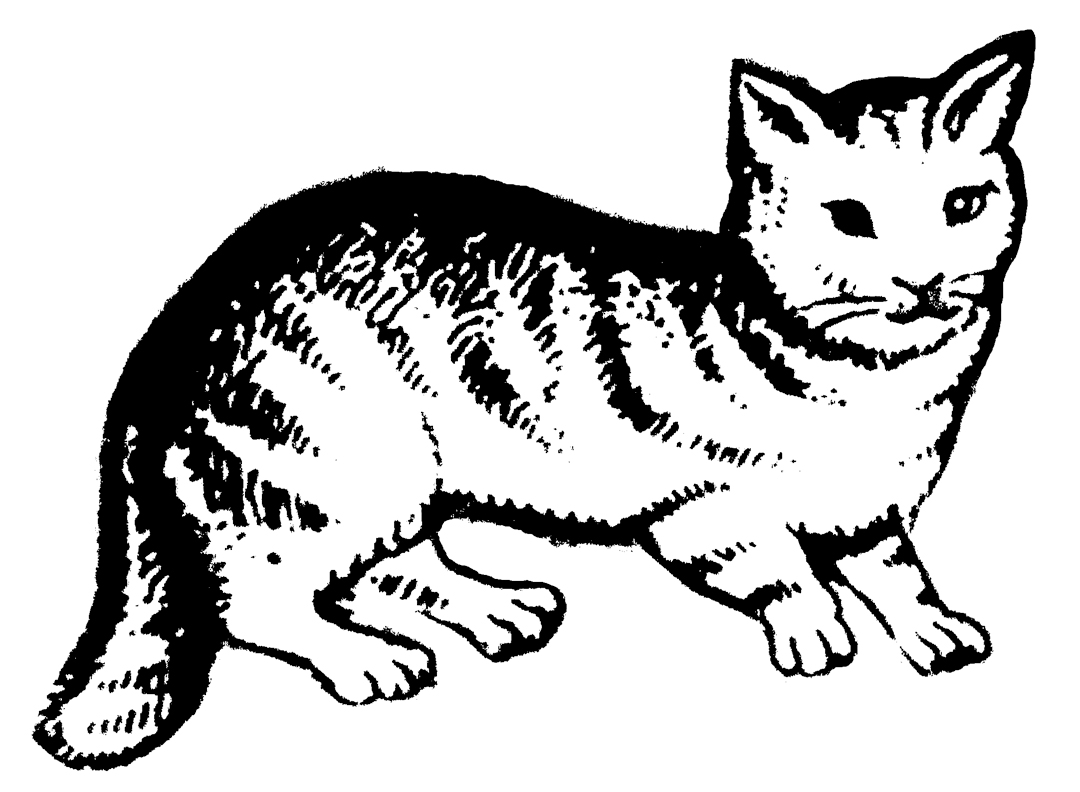
“But the mouse can make a nest in you”: Richard Kraft and Danielle Dutton appeared in CAROUSEL 37 (2016) — buy it here
